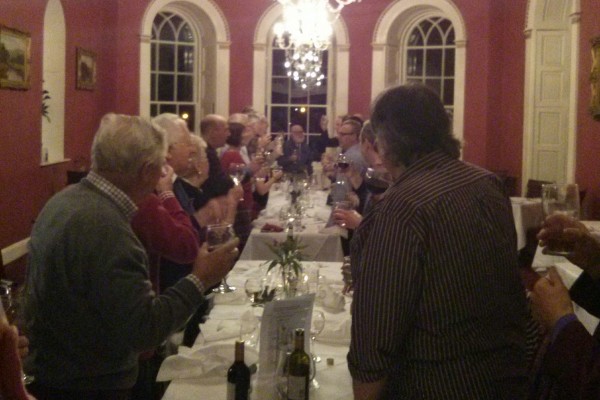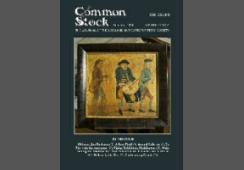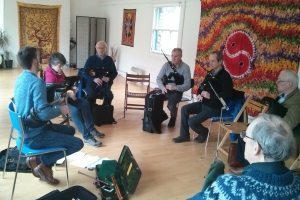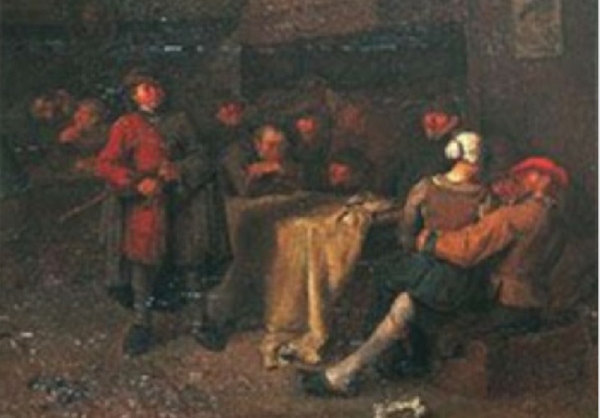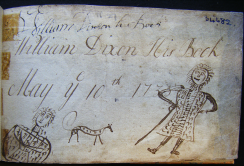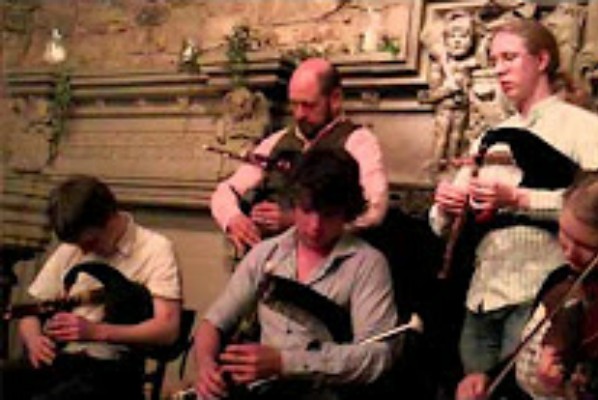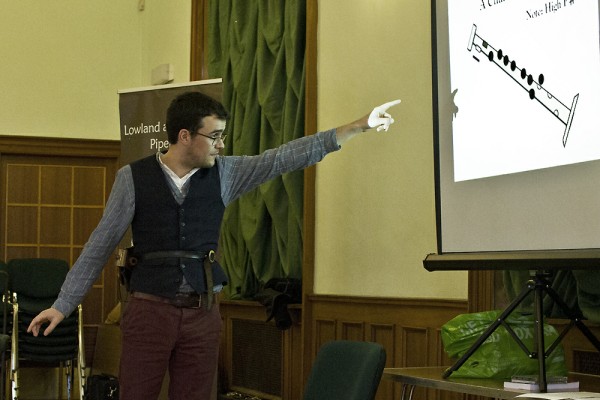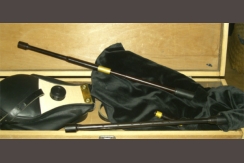


Sean Donnelly gives us an insight into the origins of the well known tune Jack Lattin, the spelling of which tends to vary in the published sources familiar to Lowland pipers.
If any tune could be said to need no introduction to readers of Common Stock that would be ‘Jack Lattin’, which is found from the early 1730s in the likes of the William Dixon MS, the Duke of Perth's MS, and various published collections.
‘Jack Lattin’ was also found in Ireland, which is no surprise, as numerous Scottish reels passed into Irish tradition during the period 1780-1800. Yet, there was a tradition current in the nineteenth century that ‘Jack Lattin’ was Irish in origin:
O’Farrell qualified it as ‘Irish’ in his 1804 tutor for the union pipes and, around the same time, Dublin music-publishers were describing it as ‘A Favourite Irish Air’. In The Panorama; or, a journey to Munster (Dublin, 1807), pp viii-ix, it was said that ‘Jack Lattin’
...was composed by a Gentleman in the County of Kildare whose name it still retains; it is a great favourite in Ireland as the Timrodee in Otaheite. The enthusiastic Composer is said to have been so transported with his own music, that he tuned his bagpipes one morning, and played and danced to it from his own house to Dublin, but died a few days after from the fatigue.
P.W. Joyce (1827-1914) in English as we speak it in Ireland (Dublin 1910), had the following to say about this marathon dancer (pp 172-3):
‘I’ll make you dance Jack Lattin'- a threat of chastisement often beard in Kildare. John Lattin of Morristown House county Kildare (near Naas) wagered he’d dance home to Morristown from Dublin - more than twenty miles - changing his dancing-steps every furlong: and won the wager. I’ll make you dance’ is a common threat heard everywhere: but ‘I’ll make you dance Jack Lattin’ is ten times worse - ‘I'll make you dance excessively.’...
It is worthy of remark that there is a well-known Irish tune called ‘Jack Lattin,’ which some of our Scotch friends have quietly appropriated, and not only that, but have turned Jack himself into a Scotchman by calling the tune ‘Jockey Latin’.
The Old English family of Lattin of Morristown Lattin had settled near Naas, co. Kildare, at the turn of the twelfth century. On the death of Patrick Lattin (1762- 1836) Morristown passed to Alexander Mansfield of Yeomanstown, co. Kildare, who was married to his daughter Pauline; their descendants continued to occupy Morristown Lattin down to the 1950s. But the memory of Jack Lattin continued to cling to his family-home. When George Mansfield (1845-1929) of Morristown Lattin died in January 1929, his obituary noted that he had been related to Jack Lattin, who had danced from Morristown to Dublin, ‘with heavy wagering on both sides’.
Among the Mansfields, the tradition was that Lattin’s marathon was much shorter and more local than the published versions had it. Sometime in the 1880s, Maude Mansfield of Earlsfort Terrace, Dublin, a great-granddaughter of Patrick Lattin’s, had told P.W. Joyce that Jack Lattin, her great-grandfather’s uncle, had been a famous dancer. He had died, aged twenty-one, in the middle of the eighteenth century, and a family rhyme had it that,
Jack Lattin dressed in satin Broke his heart of dancing;
He danced from Castle Browne To Morristown
This note is in the National Library of Ireland, MS 2983, ii, p.250, and clearly Joyce over- looked it when writing his 1910 account (which is also inaccurate in other ways). Castle Browne is approximately eight miles from Morristown Lattin.
The ancestral grave of the Lattins, in St David's Churchyard in the town of Naas itself, is marked by a handsome stone commissioned in 1719 by Patrick Lattin (1669-1732) and his wife, Jane Alcock (1674-1746) to replace a broken one dating from 1600. The first burial recorded on the stone was that of Jack Lattin, their elder son:
Here lyeth the body of JOHN LATTON Eldest
Son of the above PATRICK LATTON who Departed this life the seventh day of July 1731 in the 21st year of his age
Jack Lattin was also said to have been an excellent fiddler, and was to be found during the mid-1720s playing in a tiny inn on Dublin’s Sandymount Strand, The Conniving House. (The Lattins had a town-residence in Dublin, Lattin Court (now part of Greek Street), in the parish of St Michan's, and Jack may have been attending the school in the parish which Jesuits kept in defiance of the Penal Laws.) The writer Thomas Amory (c.1691-1788), who left Ireland for good c.1725, recalled The Conniving House in The life of Buncle Esq: (vol.1, London 1756), pp 87-8:
The Conniving House, ... was a public house, ... about a quarter of a mile beyond Rings-end, on the top of the beach, within a few yards of the sea.... Many a delightful
evening have I passed in this pretty thatched house with the famous Larrey Grogan, who played on the bag-pipes extreme[ly] well; dear Jack Lattin, matchless on the fiddle, and the most agreeable of companions, and many other delightful fellows;
who went in the days of their youth to the shades of eternity. ...
Larry Grogan, the earliest-known ‘gentleman’ Irish piper, was born in 1701 and died in Barbados, the West Indies, in the latter half of 1728 or early 1729. This ‘celebrated amateur piper’, who qualified as attorney in 1726, made a great impression on his contemporaries. He, too, gave his name to a celebrated tune, 2 jigs that Irish musicians - especially pipers - still play as ‘Coppers and Brass’ and the ‘Humours of Ennistymon’, He is said to have composed the immensely popular song ‘Ally Croker’, and the numerous songs written to ‘Larry Grogan’ throughout the eighteenth century, including one praising Grogan himself, published c.1750, and ‘The County of Limerick Buck-Hunt’ (1735), which commences “By your leave, Larry Grogan, ”.
The tunes ‘Larry Grogan’ and ‘Jack Lattin’ were already circulating in Dublin by the early 1730s; in a poem dealing with the music popular in the city during that decade a character names them when calling for his favourite tunes:
..damn you! play up the Black Joke, Or else you'll get your fiddles broke,
Then play Jack Lattin, my dear Honey! Hey! Larry Grogan for my money!
In Faulkner’s Dublin Journal, 2-5 June 1733, a forthcoming concert was advertised as including ‘... several Concerto’s on the Harp, and Jack-Latin on the Pipes, by two of the best
Masters in this Kingdom.’ In November of the next year, 1734, John Neal of Christchurch yard, Dublin, published both ‘Larry Grogan’ and ‘Jack Lattin’ in his third collection of country dances. Neal took fifty-three out of fifty-six dances from John Walsh, Caledonian Country Dances (London, 1733), the remaining being ‘Larry Grogan’ (p.3), ‘Jack Latin’ (p.15), and the 'Humours of Trim’ (p.17). John Walsh republished both tunes in Caledonian Country Dances, Book the Second (London, 1737) - ‘Jack Lattin’ (p.23) and ‘Larry Grogan’ (p.63). But while ‘Jack Latin’ is identical in both collections, Walsh’s setting of ‘Larry Grogan’ differs a good deal from Neal’s, which was a fiddle version.
The reel as a dance and tune appears to have been of Scottish (or at least northern) origin, and ‘Jack Lattin’ is a rare early example of one with Irish associations. Not surprisingly, Scottish tunes, including reels, were regarded as typical of Ulster in the 1720s and 30s. But though ‘Irish’ reels were being published by the 1750s, the dance and its music did not
become common throughout Ireland until the last quarter of the eighteenth century. How- ever, while people in Dublin and the rest of Ireland may not have been dancing Irish reels during the 1730s, they were certainly dancing Scottish ones. The collection of country dances published in Dublin and imported from London during this era contained numerous reels and other Scottish dances. In fact, the only surviving copy of Neal’s 1734, which lacks a title page, is described in a manuscript note on its first page as a collection of ‘Scotch dances’ popular in Dublin during 1736.
In Ireland the original version of ‘Jack Lattin’ remained popular as a country dance well into the early nineteenth century. It faded away thereafter, though, to be replaced, especially in Ulster by Scottish versions. In 1898, for instance, one of the tunes in the repertory of a professional piper from Farney, co. Monaghan (in south Ulster), was ‘Lock o’ Latin’, an obvious slip for ‘Jock o’ Lattin’. Part of the reason for this decline was that a different type of reel came into fashion in most parts of Ireland from the 1800s onward. If anything, Irish musicians and dancers would regard the likes of ‘Jack Lattin’ (and the contemporary ‘Rakes of Mallow’, in print already by 1733) as ‘single reels’, from their simpler rhythm and type of step used.
Some variants and relatives of ‘Jack Lattin’ have been collected from the living tradition in Ireland over the last 150 years, but no example of the original tune has ever been taken down. Several examples of elaborated Scottish versions are to be found in manuscript and collections, but these obviously derive from printed sources. The strongest trace of ‘Jack Lattin’ in Irish traditional music nowadays is the well-known Donegal reel, ‘The Pinch of Snuff’. This is occasionally called ‘Jackson’s Reel’, or ‘Jack o’ Lattin’, and the tune does share some parts with the more elaborate Scottish settings of ‘Jack Lattin’, but there is no direct resemblance between the first parts.
P.W. Joyce interpreted ‘I'll make you dance Jack Lattin’ as meaning that the victim of the threatened beating would dance, with pain, as much as Jack Lattin did. The threat, though, while referring implicitly to the marathon, can only refer directly to the dance ‘Jack Lattin’. The phrase was immortalised in literature by James Joyce (1882-1941). He had a tenuous connection with Jack Lattin in that he was educated, between 1888 and 1891, in the Jesuit college of Clongowes Wood, the Castle Browne of Lattin’s day. In Ulysses the hero Leo- pold Bloom has a sadomasochistic fantasy in which a number of elegantly-dressed Dublin society ladies - a masochist’s dream-team! - gather to thrash him for sending them anonymous obscene postcards. As ‘The Honourable Mrs Mervyn Tallboys’ prepares to set about the quivering Bloom, ‘Mrs Bellingham’ finds the prospect quite thrilling: “Tan his breech well, the upstart! Write the stars and stripes on it! ... Make him smart, Hanna dear. Give him ginger. Thrash the mongrel within an inch of his life. The cat-o’-nine tails. Geld him. Vivisect him.” But ‘Hanna dear’ is equally vivid - to Bloom's ineffable delight: “I'll scourge the pigeonlivered cur as long as I can stand over him I’ll flog him black and blue
in the public streets. I'll dig my spurs into him to the rowel.”
Sources.
Sean Donnelly, ‘A Wexford gentleman piper: “Famous Larry Grogan” (1701- 28/9), Journal of the Wexford Historical Society xvi (1996-7), 40-65.
Idem., ‘Ecstasy in eighteenth-century Kildare? The strange fate of John Lattin of Morristown Lattin (1731), Journal of the County Kildare Archaeological Society xviii, part 4 (1998-9), 565-88.

